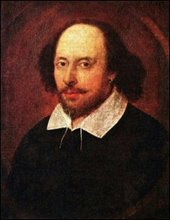
Schema: Notes Review
As we read Henry V, we will examine several literary concepts and apply them to the play. Henry V is part of the genre category of drama and is a history play (keep in mind that drama is sometimes included as a sub-genre of prose). Shakespeare wrote three types of plays: history, tragedy, and comedy. The method used by an author to develop, create or reveal characters is called characterization. There are two categories of characterization: direct, when a character is described by a narrator or another character; and indirect, which requires the reader to look for clues in dialogue, what a character thinks, and how others react to them. We will find the four character types in the play: dynamic character (those who change dramatically); round (complex and contradictory); static (essentially unchanged); and flat (functional with little depth)
We reviewed the roles of the bishops in characterization (see previous post) and in the development of the theme of God and justification. This theme is tied into Henry’s concern with legitimacy since his father committed regicide. We saw indirect characterization of Henry in his reaction to the Dauphin’s insult with the tennis balls and his handling of the traitors. In both those scenes, we also see the further development of the themes of God and justification and his leadership (we also see patriotism with his noble’s reactions to the French ambassador). Notice the motif of games: tennis with the French Ambassador; and the cat and mouse game with the traitors, when he traps them into being unmerciful to the prison he was releasing and the ‘commission’ letters that were actually death warrants.
Pay careful attention to the Chorus and what he has to say. It will help as you read the Act. Also, while we did not read the act, remember Pistol, Bardolph and Nym as symbols of Hal’s wild, youthful days. Like Falstaff, they will be rejected as he grows into a king.
Homework: Finish Act II, read Chorus of Act III…study for quiz
As we read Henry V, we will examine several literary concepts and apply them to the play. Henry V is part of the genre category of drama and is a history play (keep in mind that drama is sometimes included as a sub-genre of prose). Shakespeare wrote three types of plays: history, tragedy, and comedy. The method used by an author to develop, create or reveal characters is called characterization. There are two categories of characterization: direct, when a character is described by a narrator or another character; and indirect, which requires the reader to look for clues in dialogue, what a character thinks, and how others react to them. We will find the four character types in the play: dynamic character (those who change dramatically); round (complex and contradictory); static (essentially unchanged); and flat (functional with little depth)
We reviewed the roles of the bishops in characterization (see previous post) and in the development of the theme of God and justification. This theme is tied into Henry’s concern with legitimacy since his father committed regicide. We saw indirect characterization of Henry in his reaction to the Dauphin’s insult with the tennis balls and his handling of the traitors. In both those scenes, we also see the further development of the themes of God and justification and his leadership (we also see patriotism with his noble’s reactions to the French ambassador). Notice the motif of games: tennis with the French Ambassador; and the cat and mouse game with the traitors, when he traps them into being unmerciful to the prison he was releasing and the ‘commission’ letters that were actually death warrants.
Pay careful attention to the Chorus and what he has to say. It will help as you read the Act. Also, while we did not read the act, remember Pistol, Bardolph and Nym as symbols of Hal’s wild, youthful days. Like Falstaff, they will be rejected as he grows into a king.
Homework: Finish Act II, read Chorus of Act III…study for quiz

No comments:
Post a Comment